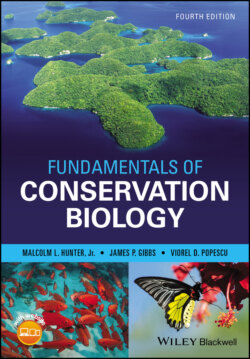Читать книгу Fundamentals of Conservation Biology - Malcolm L. Hunter Jr. - Страница 85
Diversity and Stability
ОглавлениеConservation biologists have long been concerned that species extinctions could have dire consequences for the stability of entire ecosystems. This idea is captured in a well‐known metaphor suggested by Anne and Paul Ehrlich (1981). Imagine you were flying in a plane, looked out the window, and saw a rivet fall out of the wing. You might not worry too much because there are thousands of rivets in a plane, and the loss of one rivet would not make it fall apart and crash. In fact, many rivets could probably fall out before the situation became dangerous, but, eventually, if enough rivets fell out, the plane would crash.
By analogy, an ecosystem could survive the loss of some species, but if enough species were lost, the ecosystem would be severely degraded. Of course, all the parts of a plane are not of equal importance, and, as explained in Chapter 3’s discussion of keystone, controller, and dominant species, not all species are of equal importance in an ecosystem. Thus it is possible that the loss of even a single important species could start a cascade of extinctions that might dramatically change an entire ecosystem. A good illustration of this occurred after fur hunters eliminated sea otters from some Pacific kelp bed ecosystems: the kelp beds were practically obliterated too, because, in the absence of sea otter predation, sea urchin populations exploded and consumed most of the kelp and other macroalgae (Estes et al. 1989). The likelihood of such calamities is related to the synergistic systems versus loose assemblage debate we discussed earlier (see Fig. 4.3); obviously, significant degradation is more likely if ecosystems are highly synergistic systems and the species lost are those that exert disproportionate control.
Three mechanisms for higher diversity increasing ecosystem stability have been proposed by Chapin et al. (1997). First, if there are more species in an ecosystem, then its food web will be more complex, with greater redundancy among species in terms of their ecological niche or role. In other words, in a rich system if a species is lost, there is a good chance that other species will take over its function as prey, predator, producer, decomposer, or whatever. Second, diverse ecosystems may be less likely to be invaded by new species, notably exotics that would disrupt the ecosystem’s structure and function. Third, in a species‐rich ecosystem, diseases may be less likely to spread because most species will be relatively less abundant, thus hampering transmission among individuals, and some disease organisms may be diluted among multiple host species. Variations on these themes have been proposed, such as species‐rich ecosystems being more productive because they use a site’s resources more efficiently, or species‐rich plant communities being less vulnerable to herbivory because of the dilution effect.
Research to illuminate these ideas has been accumulating, albeit slowly because of an incomplete understanding of what constitutes stability. For example, diverse grasslands are more resistant to being changed by a drought than species‐poor grasslands, but they are not more resilient in terms of recovering quickly after a drought (Isbell et al. 2015). Overall, support seems to be building, especially for the idea that redundancy is a key factor (Hooper et al. 2005; Ives and Carpenter 2007 ; Tilman et al. 2014). More specifically, having many species in an ecosystem tends to foster ecosystem stability in response to disturbances because species that perform similar ecological roles often differ in their response to disturbances. For example, a grassland with many species is more likely than a species‐poor grassland to have some drought‐tolerant plant species that could approximate the function of drought‐sensitive plants if the latter declined during a drought. Most of the support for this redundancy idea comes from network models, microbial systems, and grasslands; further research is needed on large, long‐lived species and more complex ecosystems such as forests, and this is beginning to emerge (Grossman et al. 2018). We will review the second idea, that species‐rich ecosystems are less vulnerable to invasion, in Chapter 10, “Invasive Exotics.” Finally, the idea that species‐rich ecosystems may be less susceptible to the effects of disease organisms is indirectly supported by research on parasites, such as Lyme disease spirochetes (Ostfeld and Keesing 2012 ; Civitello et al. 2015), although this is a complex, debated topic (C.L. Wood et al. 2014; Young et al. 2014).
A fourth idea about stability is particularly relevant to conservation. It emphasizes that a large ecosystem will have a large “portfolio” of diverse elements that will “perform” better over time and safeguard the system from extreme fluctuations (using language analogous to that of finance is intentional). This idea was illustrated by research on rivers that indicated that stability is an emergent property of larger, free‐flowing watersheds, which have more stable fisheries, water flows, and water temperatures (Moore et al. 2015).
